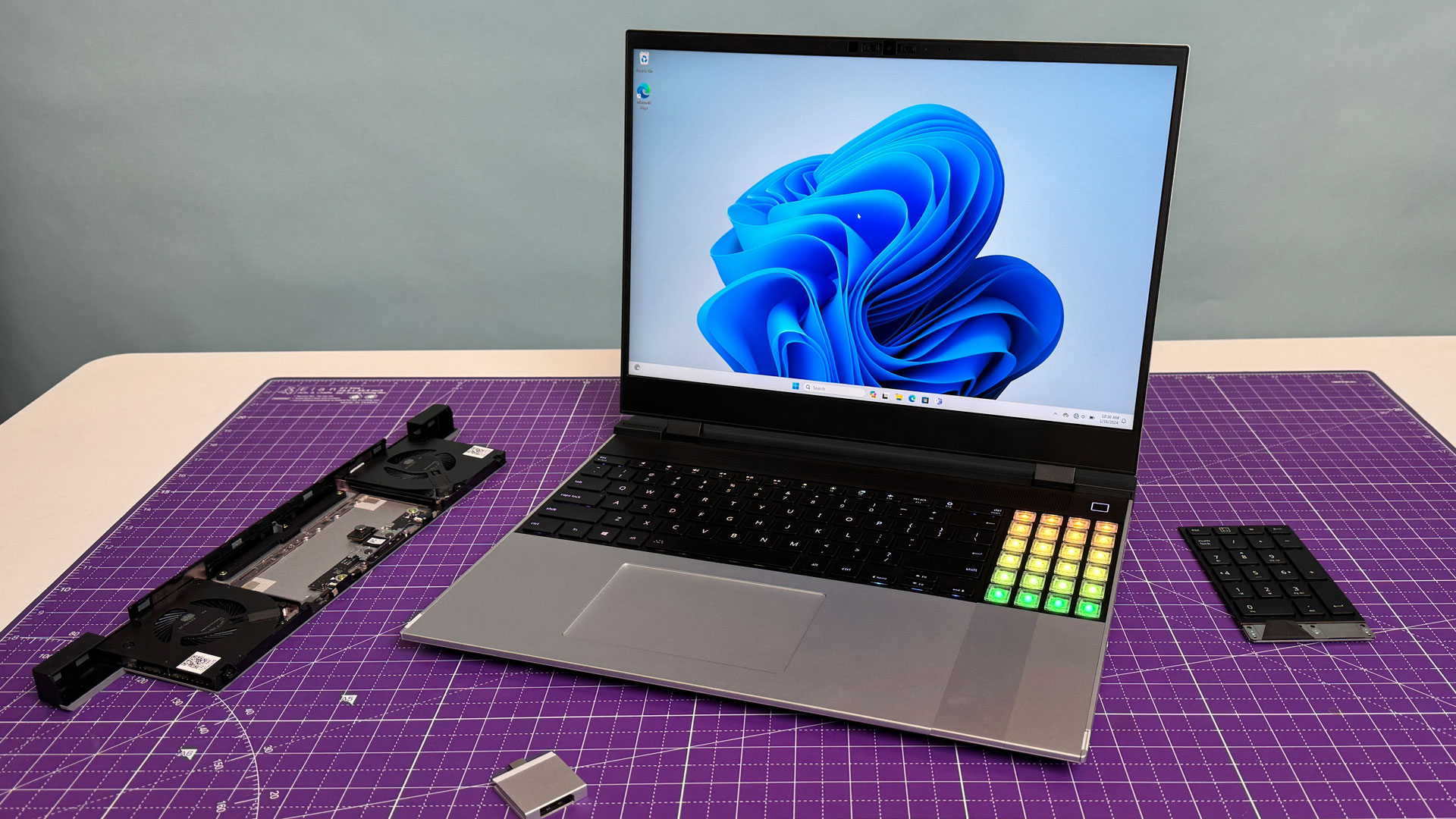Framework Laptop 16 gets a 2025 upgrade — modular notebook gets RTX 5070 graphics, Zen 5 CPU options, and 240W Type-C charger
Framework has updated its 16-inch device from top to bottom.

The Framework Laptop 16 has received its first major update since launch, featuring a plethora of upgrades to the core components, cooling, and chassis, to keep up with the latest developments in PC hardware.
The all-new 2025 version comes pre-equipped with a brand new RTX 5070 laptop GPU module, Ryzen AI CPUs, a G-Sync display, what Framework claims to be the world's first 240W Type-C charger, and more. The base price of the 2025 version has also increased to $1,499.00, making it $200 more expensive than a base model of the original Laptop 16.
The meat of the 2025 version's component upgrades is in the CPU and the GPU. The graphics module gets a massive upgrade from the Framework Laptop 16's original RX 7700S GPU to Nvidia's latest RTX 5070 Laptop GPU with 8GB of GDDR7 memory. Framework claims its RTX 5070 graphics module provides a 30-40% performance increase in games over its older AMD counterpart while operating at the same 100W TGP.
Framework also made several improvements to its RTX 5070 module besides the GPU. The heatsink now sits on a more durable Honeywell phase change thermal pad. The module has a more advanced cooling fan with "reoptimized blade geometry," and an upgraded controller IC is meant to reduce noise while still supporting the module's 100W TDP. On top of these changes, Framework also routed power and display output capabilities to the rear Type-C port.
The best part is that Framework's new RTX 5070 graphics module also works with the original version of the Framework Laptop 16, giving owners their first GPU upgrade path to date. The only con is that the new module costs a hefty $699 alone; the original 7700S version costs "just" $399.
For those that still want the Radeon RX 7700S, Framework has also created a second-generation version of its AMD-powered graphics module that incorporates the same cooling upgrades as its RTX 5070 counterpart, priced at a much lower $449. This version works with the original and 2025 versions of the Framework Laptop 16.
On the CPU side, the 2025 version of the Framework Laptop 16 comes with two new CPU options, the Ryzen AI 9 HX 370 and Ryzen AI 7 HX 350. These chips give the 2025 version access to AMD's latest Zen 5 CPU architecture as well as a higher core count on the flagship part. The original model came with options for AMD's Ryzen 9 7940HS and Ryzen 7 7840HS, both of which are Zen 4 eight-core CPUs. Framework claims the new Ryzen AI models in the 2025 version can operate at a sustained 45W TDP.
Get Tom's Hardware's best news and in-depth reviews, straight to your inbox.
For power and charging, Framework has introduced what it's calling the world's first 240W USB Type-C power adapter, featuring support for the USB-PD 3.1 spec. Framework was allegedly the first laptop maker to ship a Type-C 180W power adapter with the original Laptop 16 variant, and suspects it will be the first to ship a 240W version.
With this higher-capacity 240W power adapter, the 2025 model of the Laptop 16 will be capable of running at maximum power without draining the internal battery while plugged in.
Framework has also made several additional changes to the 2025 model; the integrated 165Hz 2560x1600 display now supports G-Sync (and connects to the discrete GPU through a mux switch). There's a new "2nd gen" webcam, a refined aluminum top cover for additional rigidity, and new keyboard artwork.
The Framework Laptop 16 remains the only true large-form-factor laptop that is customizable from the ground up, and Framework's 2025 overhaul of the Laptop 16 significantly improves the device's performance, particularly on the GPU side. However, the Laptop 16's much increased price will inevitably make it a poor candidate as a value-oriented device in the sea of RTX 5070-powered laptops out in the wild.
For reference, there are 16-inch RTX 5070-powered gaming laptops that undercut the Laptop 16 2025 model's base price, which does not even include a discrete GPU. Still, this is something we've come to expect from Framework laptops, and it's the price you pay for ultimate DIY flexibility.
It'll be interesting to see how this device competes with other gaming laptops on the market once we get the 2025 model in for review.
Follow Tom's Hardware on Google News to get our up-to-date news, analysis, and reviews in your feeds. Make sure to click the Follow button.

Aaron Klotz is a contributing writer for Tom’s Hardware, covering news related to computer hardware such as CPUs, and graphics cards.
-
Stomx Is RAM upgradeable? 99% of manufacturers now solder the RAM into the motherboards. With their 16 or rarely 32GB don't worry and be happy for the next decade ( for the decent usage of AI such laptops are already obsolete)Reply -
Notton ReplyStomx said:Is RAM upgradeable? 99% of manufacturers now solder the RAM into the motherboards. With their 16 or rarely 32GB don't worry and be happy for the next decade ( for the decent usage of AI such laptops are already obsolete)Going into the rest of the updates on Framework Laptop 16, we now offer the latest generation Ryzen™ AI 300 Series processors in 8-core AMD Ryzen™ AI 7 350 and 12-core AMD Ryzen™ AI 9 HX 370 options, both running at 45W sustained TDP. Both have highly capable integrated graphics if you’d like to use your Framework Laptop 16 with the Expansion Bay Shell instead of a Graphics Module. We’ve also updated the Mainboard design to support four simultaneous display outputs over the rear four Expansion Card slots. We of course kept memory and storage upgradeability, with two slots of DDR5-5600 supporting up to 96GB and two M.2 slots for up to 10TB.
https://frame.work/blog/introducing-the-new-framework-laptop-16-with-nvidiaFramework will tell you up front if they couldn't make a part replaceable.
Downside is DDR5-5600 is slow. -
thestryker Reply
Upside is lower latency so if this laptop is being used with one of the discrete GPU options playing games should generally be better.Notton said:Downside is DDR5-5600 is slow. -
User of Computers cool so now I can spend 5080M + 275HX money on a laptop that heats up to 50 degrees on the palmrest area because of RePaiRaBiLiTy. Definitely cool for what it is but there's a reason this hasn't seen mass market adoption.Reply -
usertests Reply
As long as they stay in business, it's all good. They did produce a relatively cheap Strix Halo product.User of Computers said:cool so now I can spend 5080M + 275HX money on a laptop that heats up to 50 degrees on the palmrest area because of RePaiRaBiLiTy. Definitely cool for what it is but there's a reason this hasn't seen mass market adoption. -
dalek1234 Reply
That's exactly what came to mind when I was reading this article.coolitic said:The customizability honestly feels kind of pointless given how expensive it is.
So one day you decide to upgrade--for example--the CPU, GPU and RAM, and you might find yourself paying more than getting a new laptop from a different manufacturer.
If they can't get the cost down, Framework won't exist anymore in a few years. -
thestryker Reply
I think the problem is that these parts specifically are very low volume. It reminds me of the mobile video docks out of China which cost $500+ for an RX 7600M. Without volume they're likely paying full rate for the GPUs which is something that is going to get passed on to the customer. I think maybe if they were to get some sort of partnership deal (nvidia probably wouldn't care about doing this, but AMD and Intel might) perhaps they could get GPUs from those respective companies at a discount, but otherwise I just don't see the costs really being what most people would consider reasonable.dalek1234 said:If they can't get the cost down, Framework won't exist anymore in a few years.
Given how well several of their models seem to sell (and the Strix Halo Desktop and motherboard aren't shipping until Q4 now) I don't think they're in any trouble of going anywhere. It's just a matter of their lower volume models/parts carrying enough higher cost than the equivalent elsewhere that one would either have to be a fan or not care about the value side to justify buying them. -
circadia Reply
any proof for the temperatures of the palm area?User of Computers said:cool so now I can spend 5080M + 275HX money on a laptop that heats up to 50 degrees on the palmrest area because of RePaiRaBiLiTy. Definitely cool for what it is but there's a reason this hasn't seen mass market adoption. -
User of Computers Reply
yes! perhaps palm area wasn't the most descriptive, but here is a FW12 that hit 62 degrees C on the bottom during a Cinebench R24 loop. this FW16 hit 48 degrees C on the keyboard deck just installing programs. This FW13 was uncomfortably warm for seemingly no reason (even in power saver mode!). Just Josh's review of the FW12 showed that keyboard temps across the entire keyboard (and palmrest) hit a peak of 56 degrees C! This is unacceptable in any laptop under any circumstance. Overall, the Framework laptop seems to have some QC issues that cause the laptop to heat up like a pot of water when under load. Can't speak to why, but it shows a lack of quality in the making of these laptops. Razer faces similar issues.circadia said:any proof for the temperatures of the palm area?